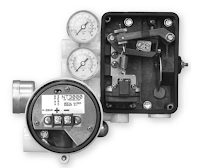 |
| Digital Positioner (Valtek) |
A valve positioner responds to a signal from some type of master control system, typically a distributed control system (DCS), a programmable logic controller (PLC), or PID controller. The control system reads a signal from a process sensor (flowmeter, temperature sensor, pressure sensor, etc...) and compares that reading to the desired setpoint. A corrective signal, based on the difference, is provided to the valve positioner which re-adjusts (if necessary) the valve position to bring the system in to equilibrium.
Valve positioners are available with pneumatic, electrical, electro-pneumatic, and digital operation. Here is a brief description of each:
Pneumatic
 |
| Pneumatic Positioner (Valtek) |
Electric
Electric valve positioners receive an electric signal, usually 4-20 mA, 1-5 VDC, 2-10 VCD or 0-10 VDC and generally drive the motors in electric actuators. They perform the same function as pneumatic positioners do, but use electricity instead of air pressure as an input signal.
Electro-Pneumatic
 |
| Electro-pneumatic Positioner (PMV) |
Valve positioners are used throughout the process industries including power, pharmaceutical, chemicals, oil and gas, food and beverage, pulp and paper, refining and petrochemicals, pipelines, and many other processes.
For more information on valve positioners, contact Swanson Flo by visiting https://swansonflo.com or by calling 800-288-7926.

